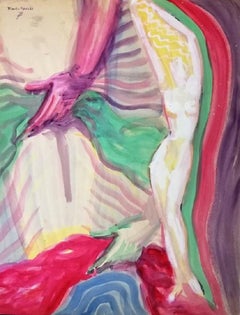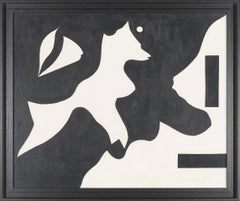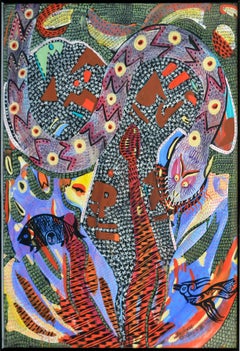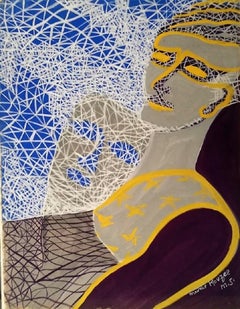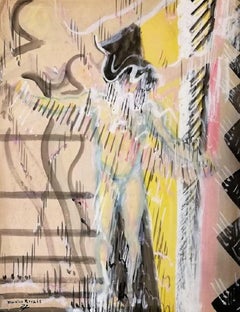Maurice Rouzée More Art
Maurice Rouzée was a French painter, designer and artist who worked especially during the first half of the 20th century. He was one of the students of Jean Cocteau. He realized many sets for the Opéra National de Paris and spent time with Cubist and Abstractionist artists.
to
1
Overall Width
to
Overall Height
to
1
1
1
1
1
1
6
335
231
205
121
Artist: Maurice Rouzée
The Body - Maurice Rouzée - 1940s - Tempera
By Maurice Rouzée
Located in Roma, IT
The Body is an original artwork realized by Maurice Rouzée in the 1940s. Hand-signed by the artist on the upper left margin. Good conditions.
The artw...
Category
1940s Modern Maurice Rouzée More Art
Materials
Tempera
Related Items
" Le Chien à la Lune. "
By André Verdet
Located in CANNES, FR
André Verdet ( 1913 - 2004 ) . Artiste français né à Nice (alpes maritimes ) mort à Saint Paul de Vence .
poète , peintre , sculpteur , céramiste , mus...
Category
1960s Modern Maurice Rouzée More Art
Materials
Casein
Snake, Large-Scale Visionary Abstract with Mystical Creatures by Barbara Carlson
By Barbara Carlson
Located in Soquel, CA
Snake, Large-Scale Visionary Abstract with Mystical Creatures by Barbara B. Carlson
Large scale abstract with Central America mythological motifs by Barbara B. Carlson an Orinda, Ca...
Category
1980s Neo-Expressionist Maurice Rouzée More Art
Materials
Tempera, Laid Paper
$2,275 Sale Price
35% Off
H 50 in W 38 in D 1 in
Modernist Abstract Bull
By Dick Crispo
Located in Soquel, CA
Unique modernist depiction of an abstracted bull by California artist Dick Crispo (American, b.1945), 1981. The earthtoned animal is outlined in bold strokes of black, and is rendered in an interesting fractured geometric style evocative of cubism's handling of perspective.
Signed and dated lower left "D. Crispo '81", and on label on verso.
Presented in a dark copper metal frame.
Image size; 22.5"H x 28.75"L.
An award winning artist, Crispo has studied at the Carmel Art Institute under John Cunningham and Sam Colburn...
Category
1980s American Modern Maurice Rouzée More Art
Materials
Tempera
1991 Modern Vintage Swedish Geometric Abstract Tempera Painting - Interaction
Located in Bristol, GB
INTERACTION
Size: 64 x 76.5 cm (including frame)
Tempera on canvas
A vibrant geometric abstract composition that explores form and interaction, executed in tempera onto canvas and d...
Category
1990s Abstract Maurice Rouzée More Art
Materials
Canvas, Tempera
$1,103
H 25.2 in W 30.12 in
Ceremonial Dancers oil and tempera painting by Julio De Diego
By Julio de Diego
Located in Hudson, NY
Artwork measures 48" x 30" and framed 56 ¼" x 38 ¼" x 3"
Provenance:
John Heller Gallery, NYC, circa 1975 (label verso)
The artist's daughter
Corbino Galleries, Sarasota, FL (1990)...
Category
1940s Modern Maurice Rouzée More Art
Materials
Masonite, Oil, Tempera
$26,000
H 48 in W 30 in
Inevitable Day – Birth of the Atom oil and tempera painting by Julio De Diego
By Julio de Diego
Located in Hudson, NY
Julio De Diego’s Atomic Series paintings made an extraordinary statement regarding the shock and fear that accompanied the dawn of the nuclear age. In the artist’s own words, “Scientists were working secretly to develop formidable powers taken from the mysterious depths of the earth - with the power to make the earth useless! Then, the EXPLOSION! . . . we entered the Atomic Age, and from there the neo-Atomic war begins. Explosions fell everywhere and man kept on fighting, discovering he could fight without flesh.”
To execute these works, De Diego developed a technique of using tempera underpainting before applying layer upon layer of pigmented oil glazes. The result is paintings with surfaces which were described as “bonelike” in quality. The forms seem to float freely, creating a three-dimensional visual effect. In the 1954 book The Modern Renaissance in American Art, author Ralph Pearson summarizes the series as “a fantastic interpretation of a weighty theme. Perhaps it is well to let fantasy and irony appear to lighten the devastating impact. By inverse action, they may in fact increase its weight.”
Bibliography
Art in America, April 1951, p.78
About this artists: Julio De Diego crafted a formidable persona within the artistic developments and political struggles of his time. The artist characterized his own work as “lyrical,” explaining, “through the years, the surrealists, the social-conscious painters and the others tried to adopt me, but I went my own way, good, bad or indifferent.” [1] His independence manifested early in life when de Diego left his parent’s home in Madrid, Spain, in adolescence following his father’s attempts to curtail his artistic aspirations. At the age of fifteen he held his first exhibition, set up within a gambling casino. He managed to acquire an apprenticeship in a studio producing scenery for Madrid’s operas, but moved from behind the curtains to the stage, trying his hand at acting and performing as an extra in the Ballet Russes’ Petrouchka with Nijinsky. He spent several years in the Spanish army, including a six-month stretch in the Rif War of 1920 in Northern Africa. His artistic career pushed ahead as he set off for Paris and became familiar with modernism’s forays into abstraction, surrealism, and cubism.
The artist arrived in the U.S. in 1924 and settled in Chicago two years later. He established himself with a commission for the decoration of two chapels in St. Gregory’s Church. He also worked in fashion illustration, designed magazine covers and developed a popular laundry bag for the Hotel Sherman. De Diego began exhibiting through the Art Institute of Chicago in 1929, and participated in the annual Chicago Artists Exhibitions, Annual American Exhibitions, and International Water Color Exhibitions. He held a solo exhibition at the Art Institute of Chicago in the summer of 1935. Though the artist’s career was advancing, his family life had deteriorated. In 1932 his first marriage dissolved, and the couple’s young daughter Kiriki was sent to live with friend Paul Hoffman.
De Diego continued to develop his artistic vocabulary with a growing interest in Mexican art. He traveled throughout the country acquainting himself with the works of muralists such as Carlos Merida, and also began a collection of small native artifacts...
Category
1940s American Modern Maurice Rouzée More Art
Materials
Masonite, Oil, Tempera
The Magician oil and tempera painting by Julio de Diego
By Julio de Diego
Located in Hudson, NY
Julio De Diego’s Atomic Series paintings made an extraordinary statement regarding the shock and fear that accompanied the dawn of the nuclear age. In the artist’s own words, “Scientists were working secretly to develop formidable powers taken from the mysterious depths of the earth - with the power to make the earth useless! Then, the EXPLOSION! . . . we entered the Atomic Age, and from there the neo-Atomic war begins. Explosions fell everywhere and man kept on fighting, discovering he could fight without flesh.”
To execute these works, De Diego developed a technique of using tempera underpainting before applying layer upon layer of pigmented oil glazes. The result is paintings with surfaces which were described as “bonelike” in quality. The forms seem to float freely, creating a three-dimensional visual effect. In the 1954 book The Modern Renaissance in American Art, author Ralph Pearson summarizes the series as “a fantastic interpretation of a weighty theme. Perhaps it is well to let fantasy and irony appear to lighten the devastating impact. By inverse action, they may in fact increase its weight.”
Exhibited
1964 Marion Koogler McNay Art Institute, San Antonio, Texas
This work retains its original frame which measures 54" x 42" x 2"
About this artist: Julio De Diego crafted a formidable persona within the artistic developments and political struggles of his time. The artist characterized his own work as “lyrical,” explaining, “through the years, the surrealists, the social-conscious painters and the others tried to adopt me, but I went my own way, good, bad or indifferent.” [1] His independence manifested early in life when de Diego left his parent’s home in Madrid, Spain, in adolescence following his father’s attempts to curtail his artistic aspirations. At the age of fifteen he held his first exhibition, set up within a gambling casino. He managed to acquire an apprenticeship in a studio producing scenery for Madrid’s operas, but moved from behind the curtains to the stage, trying his hand at acting and performing as an extra in the Ballet Russes’ Petrouchka with Nijinsky. He spent several years in the Spanish army, including a six-month stretch in the Rif War of 1920 in Northern Africa. His artistic career pushed ahead as he set off for Paris and became familiar with modernism’s forays into abstraction, surrealism, and cubism.
The artist arrived in the U.S. in 1924 and settled in Chicago two years later. He established himself with a commission for the decoration of two chapels in St. Gregory’s Church. He also worked in fashion illustration, designed magazine covers and developed a popular laundry bag for the Hotel Sherman. De Diego began exhibiting through the Art Institute of Chicago in 1929, and participated in the annual Chicago Artists Exhibitions, Annual American Exhibitions, and International Water Color Exhibitions. He held a solo exhibition at the Art Institute of Chicago in the summer of 1935. Though the artist’s career was advancing, his family life had deteriorated. In 1932 his first marriage dissolved, and the couple’s young daughter Kiriki was sent to live with friend Paul Hoffman.
De Diego continued to develop his artistic vocabulary with a growing interest in Mexican art. He traveled throughout the country acquainting himself with the works of muralists such as Carlos Merida, and also began a collection of small native artifacts...
Category
1940s American Modern Maurice Rouzée More Art
Materials
Masonite, Oil, Tempera
Modernist Abstract Dancing Figure
By Michael William Eggleston
Located in Soquel, CA
Wonderful vibrant modernist abstract figurative of a dancing man comprised of inventive shapes, colors, and forms by Michael William Eggleston (American, 20th c.). From a collection ...
Category
Early 2000s Abstract Expressionist Maurice Rouzée More Art
Materials
Paper, Ink, Tempera
$555 Sale Price
35% Off
H 24 in W 19 in D 0.1 in
Desert Landscape Painting
Located in Houston, TX
Modern acrylic and tempera abstract landscape of a mesa land formation under a darkening sky by artist Lilian Coket, 2000.
Original artwork on paper displayed on a white mat with a ...
Category
21st Century and Contemporary Maurice Rouzée More Art
Materials
Acrylic, Paper, Tempera
St. Atomic oil and tempera painting by Julio de Diego
By Julio de Diego
Located in Hudson, NY
Julio De Diego’s Atomic Series paintings made an extraordinary statement regarding the shock and fear that accompanied the dawn of the nuclear age. In the artist’s own words, “Scientists were working secretly to develop formidable powers taken from the mysterious depths of the earth - with the power to make the earth useless! Then, the EXPLOSION! . . . we entered the Atomic Age, and from there the neo-Atomic war begins. Explosions fell everywhere and man kept on fighting, discovering he could fight without flesh.”
To execute these works, De Diego developed a technique of using tempera underpainting before applying layer upon layer of pigmented oil glazes. The result is paintings with surfaces which were described as “bonelike” in quality. The forms seem to float freely, creating a three-dimensional visual effect. In the 1954 book The Modern Renaissance in American Art, author Ralph Pearson summarizes the series as “a fantastic interpretation of a weighty theme. Perhaps it is well to let fantasy and irony appear to lighten the devastating impact. By inverse action, they may in fact increase its weight.”
Exhibited
1950 University of Illinois at Urbana "Contemporary American Painting"
1964 Marion Koogler McNay Art Institute, San Antonio, Texas
This work retains its original frame which measures 54" x 36" x 2".
About this artist: Julio De Diego crafted a formidable persona within the artistic developments and political struggles of his time. The artist characterized his own work as “lyrical,” explaining, “through the years, the surrealists, the social-conscious painters and the others tried to adopt me, but I went my own way, good, bad or indifferent.” [1] His independence manifested early in life when de Diego left his parent’s home in Madrid, Spain, in adolescence following his father’s attempts to curtail his artistic aspirations. At the age of fifteen he held his first exhibition, set up within a gambling casino. He managed to acquire an apprenticeship in a studio producing scenery for Madrid’s operas, but moved from behind the curtains to the stage, trying his hand at acting and performing as an extra in the Ballet Russes’ Petrouchka with Nijinsky. He spent several years in the Spanish army, including a six-month stretch in the Rif War of 1920 in Northern Africa. His artistic career pushed ahead as he set off for Paris and became familiar with modernism’s forays into abstraction, surrealism, and cubism.
The artist arrived in the U.S. in 1924 and settled in Chicago two years later. He established himself with a commission for the decoration of two chapels in St. Gregory’s Church. He also worked in fashion illustration, designed magazine covers and developed a popular laundry bag for the Hotel Sherman. De Diego began exhibiting through the Art Institute of Chicago in 1929, and participated in the annual Chicago Artists Exhibitions, Annual American Exhibitions, and International Water Color Exhibitions. He held a solo exhibition at the Art Institute of Chicago in the summer of 1935. Though the artist’s career was advancing, his family life had deteriorated. In 1932 his first marriage dissolved, and the couple’s young daughter Kiriki was sent to live with friend Paul Hoffman.
De Diego continued to develop his artistic vocabulary with a growing interest in Mexican art. He traveled throughout the country acquainting himself with the works of muralists such as Carlos Merida, and also began a collection of small native artifacts...
Category
1940s American Modern Maurice Rouzée More Art
Materials
Masonite, Oil, Tempera
Abstract in Blues and Purples
Located in Houston, TX
Mid-century abstract in oil and tempera by French artist Hervet in cool tones of blues and purples, signed lower right.
Original artwork on paper dis...
Category
1960s Maurice Rouzée More Art
Materials
Oil, Tempera
Georgian Contemporary Art by Giorgi Kavelashvili - Expand
Located in Paris, IDF
Acrylic, tempera on wood panel
Giorgi Kavelashvili is a Georgian artist born in 1994 who lives and works in Tbilisi, Georgia. He is graduated from the Tbilisi State Academy of Arts,...
Category
2010s Abstract Maurice Rouzée More Art
Materials
Canvas, Acrylic, Tempera, Wood Panel
$4,300
H 43.31 in W 43.31 in D 1.78 in
Previously Available Items
Purple Composition - Maurice Rouzée - 1940s - Tempera
By Maurice Rouzée
Located in Roma, IT
Purple Composition is an original artwork realized by Maurice Rouzée in the 1940s. Hand-signed by the artist on the lower right margin (Maurice Rouzée M...
Category
1940s Modern Maurice Rouzée More Art
Materials
Tempera
H 25.6 in W 19.69 in D 0.04 in
Pink Dream - Maurice Rouzée - 1940s - Tempera
By Maurice Rouzée
Located in Roma, IT
Pink Dream is an original artwork realized by Maurice Rouzée in the 1940s. Signed on plate by the artist on the lower left margin. Good conditions.
The...
Category
1940s Modern Maurice Rouzée More Art
Materials
Tempera
Lovers - Maurice Rouzée - 1940s - Tempera
By Maurice Rouzée
Located in Roma, IT
Lovers is a beautiful original painting realized by Maurice Rouzée in 1942. Signed and dated on the upper right margin (Maurice Rouzée 11.42). Good cond...
Category
1940s Modern Maurice Rouzée More Art
Materials
Tempera
The Dance - Maurice Rouzée - 1940s - Tempera
By Maurice Rouzée
Located in Roma, IT
The Dance is an original artwork realized by Maurice Rouzée in the 1940s. Tempera on paper. Signed by the artist on the lower left. Good conditions exce...
Category
1940s Modern Maurice Rouzée More Art
Materials
Tempera
Maurice Rouzée more art for sale on 1stDibs.
Find a wide variety of authentic Maurice Rouzée more art available for sale on 1stDibs. You can also browse by medium to find art by Maurice Rouzée in paint, tempera and more. Much of the original work by this artist or collective was created during the 1940s and is mostly associated with the modern style. Not every interior allows for large Maurice Rouzée more art, so small editions measuring 20 inches across are available. Customers who are interested in this artist might also find the work of Filippo De Pisis, Carmie, and Renato Guttuso. Maurice Rouzée more art prices can differ depending upon medium, time period and other attributes. On 1stDibs, the price for these items starts at $269 and tops out at $269, while the average work can sell for $269.
